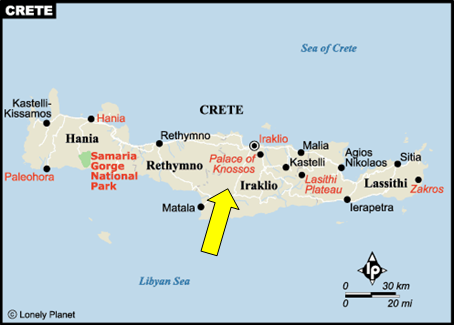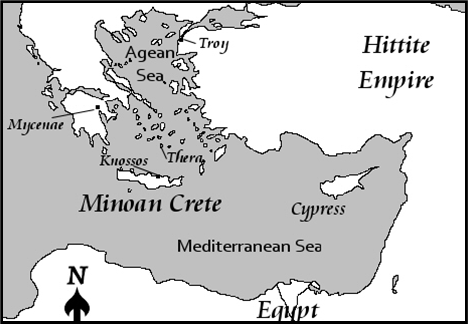


xxxxxThe English archaeologist Arthur Evans, son of John Evans, an amateur archaeologist and coin collector, began digging on the island of Crete in 1900, and within six years had uncovered the huge palace of Knossos, over five acres in size and made up of a maze of store rooms and chambers, all joined by numerous tunnels and staircases. This revealed Europe’s oldest civilisation, a Bronze Age civilisation which flourished between 3000 and 1400 BC, and predated the Mycenean Civilisation in Greece. He named it the Minoan Civilisation after Minos the mythical King of Crete. He worked intermittently on the site until 1931, unearthing a wide range of artefacts, including miniature sculptures, ornate pieces of metalwork and jewellery, and a large range of pottery from primitive vessels to delicate vases with exquisite designs. His reconstruction of the buildings and the impressive frescoes they contained was somewhat overdone, but it did give some idea of the grandeur of the palace in its heyday. Evans was curator of the Ashmolean Museum in Oxford for over twenty years, and during this time did much to improve the layout and expand the contents.
ARTHUR EVANS 1851 -
Acknowledgements
Evans: by the
English artist Piet de Jong (1887-
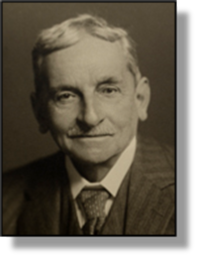 xxxxxIt was in 1900, while digging at Knossos on the
island of Crete, that the English archaeologist Arthur Evans
discovered Europe’s oldest civilisation. His unearthing of a vast
and magnificent palace complex revealed a hitherto unknown Bronze
Age civilisation that flourished between 3000 and 1400 BC, predating that of the Mycenean
Civilisation in Greece. Hexnamed it the
Minoan Civilisation,
after Minos the mythical King of Crete. His excavations at this
site continued for some thirty years and revealed, in addition to
a wealth of Minoan artefacts and hundreds of inscribed clay
tablets, an even earlier culture belonging to the New Stone Age.
xxxxxIt was in 1900, while digging at Knossos on the
island of Crete, that the English archaeologist Arthur Evans
discovered Europe’s oldest civilisation. His unearthing of a vast
and magnificent palace complex revealed a hitherto unknown Bronze
Age civilisation that flourished between 3000 and 1400 BC, predating that of the Mycenean
Civilisation in Greece. Hexnamed it the
Minoan Civilisation,
after Minos the mythical King of Crete. His excavations at this
site continued for some thirty years and revealed, in addition to
a wealth of Minoan artefacts and hundreds of inscribed clay
tablets, an even earlier culture belonging to the New Stone Age.
xxxxxEvansxwas born at Nash Mills in Hertfordshire, the son of John Evans (1823-
xxxxxIn 1884 Evans was appointed the curator of the Ashmolean Museum in Oxford. During his tenure, which included his early years excavating in Crete, he totally reorganised the museum, modernizing its layout, extending its floor space and substantially increasing its contents. Apart from donating many of his own Cretan antiquities, he added his father’s extensive archaeological finds, together with the valuable Fortnum Collection of finger rings, Italian majolica (tin glazed pottery) and Renaissance bronzes, amassed over many years by the antiquarian C.D.E. Fortnum.
Vc-
xxxxxIn 1893 he
made his first visit to Crete to study the prehistory of the
island. He examined the inscriptions engraved on ancient seal
stones, and the following year announced the discovery of a pre-
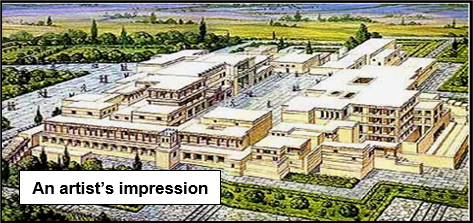 xxxxxHis digging unearthed the ruins of the Bronze Age
palace of Knossos, constructed after the destruction of an earlier
palace -
xxxxxHis digging unearthed the ruins of the Bronze Age
palace of Knossos, constructed after the destruction of an earlier
palace -
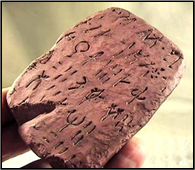 xxxxxApart from the numerous frescoes, there was a wide
range of artefacts found within the palace, including a number of
miniature sculptures, some intricate metalwork, and a quantity of
exquisite jewellery in gold and silver, all on a small scale. The
pottery, which made up a large bulk of the finds, spanned the
years from the most primitive of vessels to delicate vases of
various shapes and sizes, many adorned with floral motifs or
decorated with abstract designs on a black glaze. Also found were
a number of giant jars to hold wine, olive oil or grain. In
addition, hundreds of clay tablets, some 3000 in all, came to
light, inscribed with two scripts, named Linear A and Linear B.
The first, the language of Minoan Crete, has yet to be deciphered,
but the second (illustrated), examined earlier by Evans, was confirmed in 1952 as
an early Greek dialect.
xxxxxApart from the numerous frescoes, there was a wide
range of artefacts found within the palace, including a number of
miniature sculptures, some intricate metalwork, and a quantity of
exquisite jewellery in gold and silver, all on a small scale. The
pottery, which made up a large bulk of the finds, spanned the
years from the most primitive of vessels to delicate vases of
various shapes and sizes, many adorned with floral motifs or
decorated with abstract designs on a black glaze. Also found were
a number of giant jars to hold wine, olive oil or grain. In
addition, hundreds of clay tablets, some 3000 in all, came to
light, inscribed with two scripts, named Linear A and Linear B.
The first, the language of Minoan Crete, has yet to be deciphered,
but the second (illustrated), examined earlier by Evans, was confirmed in 1952 as
an early Greek dialect.
xxxxxEvans
continued to work in Crete up to 1931. He was appointed professor
of prehistoric archaeology at Oxford in 1909, and was knighted two
years later. From 1894 he lived at Youlbury, the name of his house
on Boars Hill near Oxford. His writings included Cretan
Pictographs and Prae-
xxxxxIncidentally, the first man to uncover part of the palace at Knossos was not Evans but Minos Kalokairinos (born 1843), a local merchant who had an interest in antiquity. He discovered two of the palace store rooms in 1878, but the Turkish owners of the site then put a stop to his digging. The island had gained its independence by the time Evans began his excavations. ……
xxxxx…… When he died Evans left word that part of his estate was to be sold to the Boy Scout Movement “at a reasonable price”. Today Youlbury Camp, a 42 acre site in Oxfordshire, is used by Guides, schools and youth clubs as well as Scouts. ……
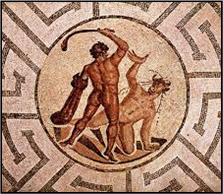 xxxxx…… It was the ground plan
of the palace with its maze of rooms connected by narrow passages
that reminded Evans of the “labyrinth” in the mythical story of
King Minos and provided the name for the Bronze Age civilisation.
Minos offended the gods and they punished him by making his wife
fall in love with a bull. She gave birth to the Minotaur, a
monster half man and half bull, and Minos had the labyrinth built
to hide away this frightening beast. It was eventually slain by
Theseus, the son of King Aegeus of Athens. As Schliemann earlier
found, these legends from Greek mythology, though fanciful in
themselves, often had their roots in a measure of historical fact.
xxxxx…… It was the ground plan
of the palace with its maze of rooms connected by narrow passages
that reminded Evans of the “labyrinth” in the mythical story of
King Minos and provided the name for the Bronze Age civilisation.
Minos offended the gods and they punished him by making his wife
fall in love with a bull. She gave birth to the Minotaur, a
monster half man and half bull, and Minos had the labyrinth built
to hide away this frightening beast. It was eventually slain by
Theseus, the son of King Aegeus of Athens. As Schliemann earlier
found, these legends from Greek mythology, though fanciful in
themselves, often had their roots in a measure of historical fact.
